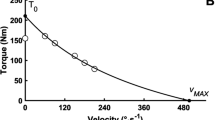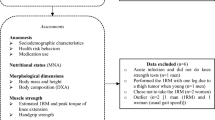Abstract
OBJECTIVE: To depict the general trends of muscle anaerobic performance in obese subjects within a wide range of age and body weight.
DESIGN: Cross-sectional study for the measurement of lower limb maximal anaerobic power output with a modification of the Margaria stair climbing test in a large population of obese subjects of both genders within a wide span of age (18–80 y) and body mass index (BMI, 30–68 kg m−2). Furthermore, body composition was also determined by bioimpedance analysis in a representative subgroup, in order to evaluate the relationships between fat-free mass (FFM) and power output.
SUBJECTS: A total of 1298 obese subjects (486 males, 812 females) from an Italian population seeking medical support for body weight reduction. Within this sample, a consistent subgroup of 193 subjects (59 males, 134 females) was also selected for accessory study of body composition.
RESULTS: In general, male subjects developed significantly higher lower limb power output (Ẇ) than female subjects (P<0.001–0.01), both in absolute terms and per unit body mass. In both genders, Ẇ was influenced negatively by age (P<0.001) and positively by BMI (P<0.001). While the effect of age was similar in both genders, BMI had a different positive effect in male and in female subjects, being more definite in male subjects. In the subgroup, FFM was found to depend both on age and BMI, in a fashion comparable with that displayed by Ẇ. The gender-related differences in Ẇ disappeared when expressed per unit FFM and a significant linear correlation was found between FFM and Ẇ, both in male and female subjects (R2=0.32–0.51, P<0.001).
CONCLUSIONS: The lower limb maximal power output is significantly higher in obese male subjects than in female subjects, being negatively influenced by age but positively related to BMI. Female subjects appear to be at a greater disadvantage for effect of obesity, the major motor limitations being suffered by older women with higher BMI. These gender differences in age- and BMI-dependent Ẇ changes seem to be related to changes in FFM in the subgroup in whom body composition was studied.
This is a preview of subscription content, access via your institution
Access options
Subscribe to this journal
Receive 12 print issues and online access
$259.00 per year
only $21.58 per issue
Buy this article
- Purchase on Springer Link
- Instant access to full article PDF
Prices may be subject to local taxes which are calculated during checkout




Similar content being viewed by others
References
Flegal KM . The obesity epidemic in children and adults: current evidence and research issues. Med Sci Sport Exerc 1999; 31: S509–S514.
Mokdad AH, Serdula MK, Dietz WH, Bowman BA, Marks JS, Koplan JP . The continuing epidemic of obesity in the United Ststes. J Am Med Assoc 2000; 284: 1650–1651.
Must A, Spadano J, Coakley EH, Field AE, Colditz G, Dietz WH . The disease burden associated with overweight and obesity. J Am Med Assoc 1999; 282: 1523–1529.
Allison DB, Fontaine KR, Manson JE, Stevens J, Vanltallie TB . Annual deaths attributable to obesity in the United States. J Am Med Assoc 1999; 282: 1530–1538.
Han TS, Tijhuis MA, Lean ME, Seidall JC . Quality of life in relation to overweight and body fat distribution. Am J Public Health 1998; 88: 1814–1820.
Evers Larsson U, Mattsson E . Functional limitations linked to high body mass index, age and current pain in obese women. Int J Obes Relat Metab Disord 2001; 25: 893–899.
Hulens M, Vansant G, Lysens R, Claessens AL, Muls E . Exercise capacity in lean versus obese women. Scand J Med Sci Sports 2001; 11: 305–309.
Barofsky I, Fontaine KR, Cheskin LJ . Pain in the obese: impact on health-related quality-of-life. Ann Behav Med 1998; 19: 408–410.
Doll HA, Petersen SE, Stewart-Brown SL . Obesity and physical and emotional well-being: associations between body mass index, chronic illness, and the physical and mental components of the SF-36 questionnaire. Obes Res 2000; 8: 160–170.
Lafortuna CL, Fumagalli E, Vangeli V, Sartorio A . Lower limb alactic anaerobic power output assessed with different techniques in morbid obesity. J Endocrinol Invest 2002; 25: 134–141.
Sartorio A, Lafortuna CL, Conte G, Faglia G, Narici MV . Changes in motor control and performance after a short term body mass reduction program in obese subjects. J Endocrinol Invest 2001; 24: 393–398.
Sartorio A, Narici MV, Fumagalli E, Faglia G, Lafortuna CL . Aerobic and anaerobic performance before and after a short-term body mass reduction program in obese subjects. Diab Nutr Metab 2001; 14: 51–57.
Sartorio A, Fontana P, Trecate L, Lafortuna CL . Short-term changes of fatigability and muscle performance in severe obese patients after an integrated body mass reduction program. Diab Nutr Metab 2003; 16: 88–93.
Jebb SA, Moore MS . Contribution of sedentary lifestyle and inactivity to the etiology of overweight and obesity: current evidence and research issues. Med Sci Sports Exerc 1999; 31: S534–S541.
Hochberg Z, Hertz P, Colin V, Ish-Shalom S, Yeshurun D, Youdim MB, Amit T . The distal axis of growth hormone (GH) in nutritional disorders: GH-binding protein, insulin-like growth factor-I (IGF-I) and IGF-I receptors in obesity and anorexia nervosa. Metabolism 1992; 41: 106–112.
Margaria R, Aghemo P, Rovelli E . Measurement of muscular power (anaerobic) in man. J Appl Physiol 1966; 21: 1662–1664.
Bosco C, Luhtanen P, Komi PV . A simple method for measurement of mechanical power in jumping. Eur J Appl Physiol 1983; 50: 273–282.
Lukaski HC, Bolonchuk WW, Hall CB, Siders WA . Validation of tetrapolar bioelectrical measurements to assess human body composition. J Appl Physiol 1986; 60: 1327–1332.
Gray DS, Bray GA, Gemayel N, Kaplan K . Effects of obesity on bioelectrical impedance. Am J Clin Nutr 1989; 50: 255–260.
Zar JH . Biostatistical analysis. Prentice-Hall International Editions: Englewood Cliffs, NJ, USA; 1984, pp 292–305.
Narici M, Bordini M, Cerretelli P . Effect of aging on human adductor pollicis muscle function. J Appl Physiol 1991; 71: 1227–1281.
Lindle RS, Metter EJ, Lynch NA, Fleg JL, Fozard JL, Tobin J, Roy TA, Hurley BF . Age and gender comparison of muscle strength in 654 women and men aged 20–93 y. J Appl Physiol 1997; 83: 1581–1587.
Izquierdo M, Ibanez J, Gorostiaga E, Garrues M, Zuniga A, Anton A, Larrion JL, Hakkinen K . Maximal strength and power characteristics in isometric and dynamic actions of the upper and lower extremities in middle-aged and older men. Acta Physiol Scand 1999; 167: 57–68.
De Vito G, Bernardi M, Forte R, Pulejo C, Macaluso A, Figura F . Determinants of maximal instantaneous muscle power in women aged 50–75 years. Eur J Appl Physiol Occup Physiol 1998; 78: 59–64.
Kyle UG, Genton L, Slosman DO, Pichard C . Fat-free and fat mass percentiles in 5225 healthy subjects aged 15 to 98 years. Nutrition 2001; 17: 534–541.
Frontera WR, Hughes VA, Lutz KJ, Evans WJ . A cross-sectional study of muscle strength and mass in 45- to 78-yr-old men and women. J Appl Physiol 1991; 71: 644–650.
Hakkinen K, Pakarinen A . Muscle strength and serum testosterone, cortisol and SHBG concentrations in middle-aged and elderly men and women. Acta Physiol Scand 1993; 148: 199–207.
Izquierdo M, Aguado X, Gonzalez R, Lopez JL, Hakkinen K . Maximal and explosive force production capacity and balance performance in men of different ages. Eur J Appl Physiol Occup Physiol 1999; 79: 260–267.
Young A . Ageing and physiological functions. Philos Trans R Soc Lond B Biol Sci 1997; 352: 1837–1843.
Caiozzo VJ, Kyle CR . The effect of external loading upon power output in stair climbing. Eur J Appl Physiol Occup Physiol 1980; 44: 217–222.
Kyle CR, Caiozzo VJ . A comparison of the effect of external loading upon power output in stair climbing and running up a ramp. Eur J Appl Physiol Occup Physiol 1985; 54: 99–103.
Kitagawa K, Suzuki M, Miyashita M . Anaerobic power output of young obese men: comparison with non-obese men and the role of excess fat. Eur J Appl Physiol Occup Physiol 1980; 43: 229–234.
Acknowledgements
The study was partially supported by Progetti di Ricerca Corrente (Istituto Auxologico Italiano, IRCCS, Milano and Piancavallo). We thank Dr G Silvestri, A Tibaldi, M Resnik, Ms F Pera (headnurse) and the nursing staff at the 3rd Division of Metabolic Diseases for their appreciated professional contribution. Mr S Ottolini is acknowledged for his technical assistance in database management.
Author information
Authors and Affiliations
Corresponding author
Rights and permissions
About this article
Cite this article
Sartorio, A., Proietti, M., Marinone, P. et al. Influence of gender, age and BMI on lower limb muscular power output in a large population of obese men and women. Int J Obes 28, 91–98 (2004). https://doi.org/10.1038/sj.ijo.0802433
Received:
Revised:
Accepted:
Published:
Issue Date:
DOI: https://doi.org/10.1038/sj.ijo.0802433
Keywords
This article is cited by
-
Impacts of obesity and stress on neuromuscular fatigue development and associated heart rate variability
International Journal of Obesity (2015)
-
Role of obesity on cerebral hemodynamics and cardiorespiratory responses in healthy men during repetitive incremental lifting
European Journal of Applied Physiology (2015)
-
The energy cost of cycling and aerobic performance of obese adolescent girls
Journal of Endocrinological Investigation (2009)
-
Allometric scaling of isometric biceps strength in adult females and the effect of body mass index
European Journal of Applied Physiology (2008)
-
The energetic and cardiovascular response to treadmill walking and cycle ergometer exercise in obese women
European Journal of Applied Physiology (2008)



